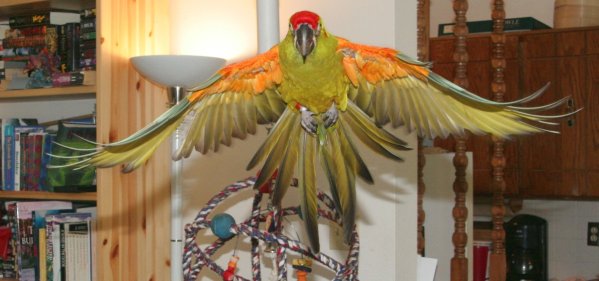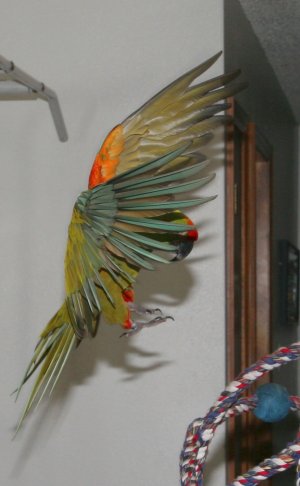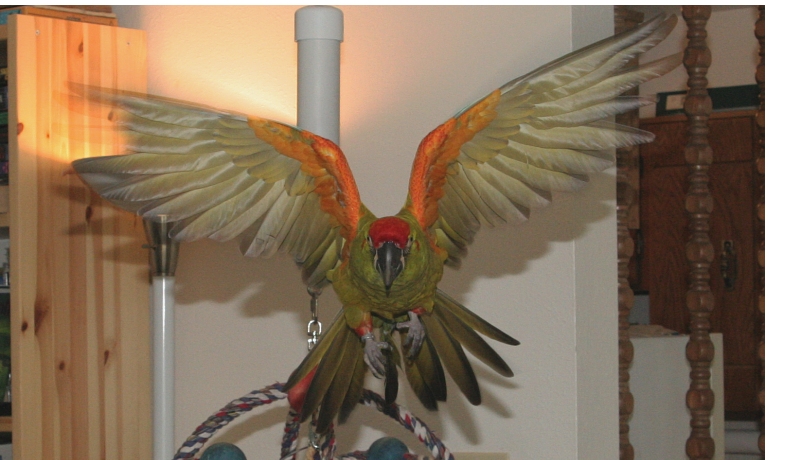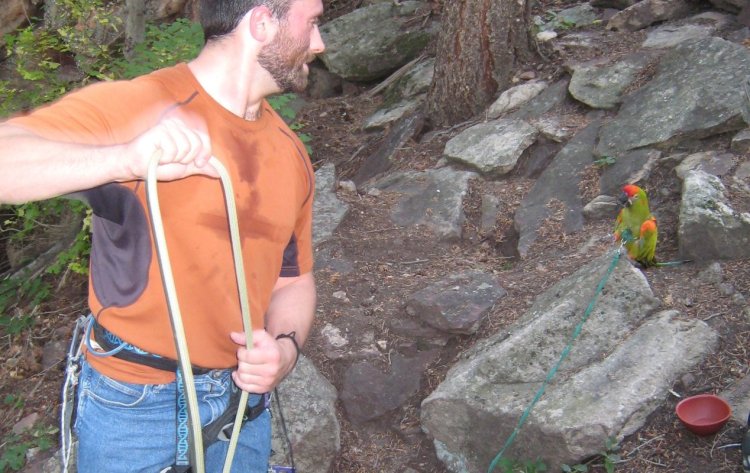Merlin - The Red Fronted Macaw, Ara rubrogenys
Merlin the Super Red Front
Videos, language, and pictures
Red Front Info
Good Red Front News
MERLIN, MY BEST BUDDY RED FRONT

This is my buddy Merlin. You can find more pictures and movies of him below. Merlin is a Red Fronted Macaw born April 30th, 2004. We bought him from an aviary called Avalon Aviary. The aviary is run by a fantastic woman named Suzanne who has spent about a year with us helping us to decide what kind of bird would be right for us and teaching us all about each species. I would highly recommend anyone looking for a bird go to Avalon Aviary.
This species of Macaw hails from Bolivia and there are apparently less than two thousand of them remaining in the wild. Sadly, it appears that habitat destruction and outright murder by the ignorant savages who kill them when they stop to eat corn and nuts will likely ensure their extinction in the wild. I realize some people have problems with keeping birds as pets but, after some research, it is abundantly cleat that many species of birds we keep as pets would go the way of the Dodo if not for the interest by owners and Aviaries.

Red Fronts are absolute charms, they have all the goofiness of caiquies coupled with the energy of Amazons, the flight ability of hummingbirds, and the cuddliness of bigger macaws. They are also breeding well in captivity so owning one doesn't strain the breeding pool like owning a Blue Throated Macaw would.
Our little guy is a sweet, bright, and affectionate little bird, he gets on well with the cats and exhibits the uncanny ability to know quickly if someone likes him or not. Within two days of owning him he took to one friend (Brian) immediately and made threatening gestures to another (Kevin) within 30 seconds of meeting him.
We have chosen to allow Merlin to remain flighted. This opens up a whole new can of trouble as we must be more vigilant that he does not escape or fly into harm (or destroy household items). In my personal opinion birds should be kept flighted if at all possible. I know this is not always possible with smaller birds but if you can devote the attention necessary to keep your bird flighted they will be much happier, much more pig headed but much happier. Red Fronts in particular are fantastic fliers, Merlin can take off vertically, hover, and fly backwards, it is a treat to watch. Unlike many other species of birds Red Fronts delight in constant flight, clipping one would be like hobbling a marathon runner.
If you get a Red Front and then clip it, you are destroying much of what makes them such wonderful creatures. People will give you a hundred reasons to clip a bird butI can offer one simple counter, 'It is a bird'. If you are really prepared to devote to decades of patience with one of these creatures then why can't you devote yourself to the diligence required to keeping it safe while still allowing it to be a creature that is uniquely defined by its ability to fly?
Merlin goes everywhere with me. I have attached a bungie cord to his harness so he does not get snapped back when I fly him outdoors. He goes on walks with me, has been up to the top oflocal 7000-8500 foot peaks with me over a two hundred times, been on my shoulder when I am am climbing moderate sport routes, and is known by tons of people in Boulder stores. Merlin has even been on traditional rock climbing routes and long overhanging rapells with me.
Merlin is a goofy little fellow and likes to fly over to me and bite me before yelling 'Ouch' and also likes to wrestle on the floor and play dead when I make a shooting gesture at him. If you get a Red Front be aware that they have very high energy levels and need a great deal of interaction. They also can get quite willfull for a period of time and require consistency in dealing with.
Red Fronts also have a rather shrill call. Be prepared to deal with it. We have trained Merlin to use words, signals, or actions (such as shaking a door handle) to indicate what he wants and this has greatly cut down on the yelling but it took time and he still occasionally sounds off. Check one of my videos to get an idea for the sound they make.

An interesting thing about Macaws is that they use words contextually. Some people think parrots are mimics which is incorrect, they are actually using language to communicate. Our guy has a problem with the letter C and TH and S sounds so 'Come Come' sounds like 'om om' and 'Thirsty' sounds like 'her he'

UPDATE- As of April, 2010 we now have Merlin's brother, Chaco living
with us, whoever his last owner's were should be ashamed as one of them
clearly abused him. We have also picked up Rio, Merlin's and
Chaco's older brother from a previous clutch. To Rio's owners I
say Kudos, you obviously treated him with love and respect. If
anyome out there has more than 3 red fronts I'd love to hear of it.

 Hello
Hello


